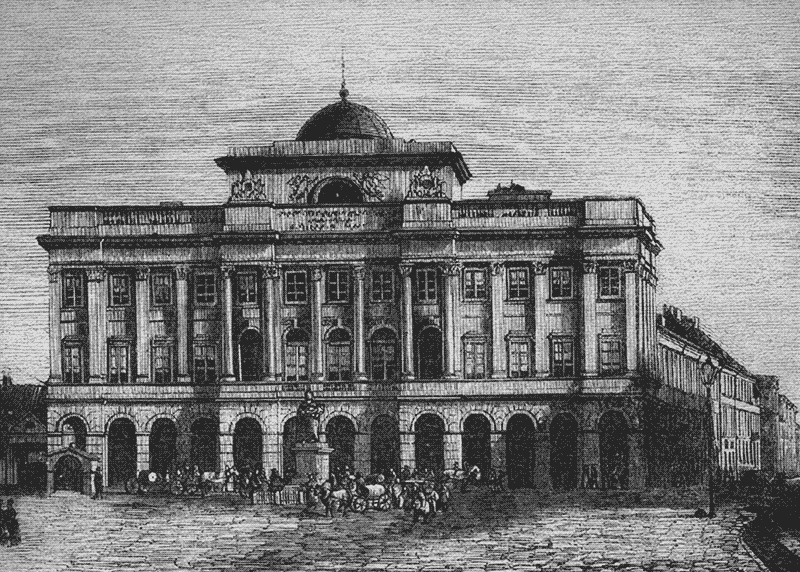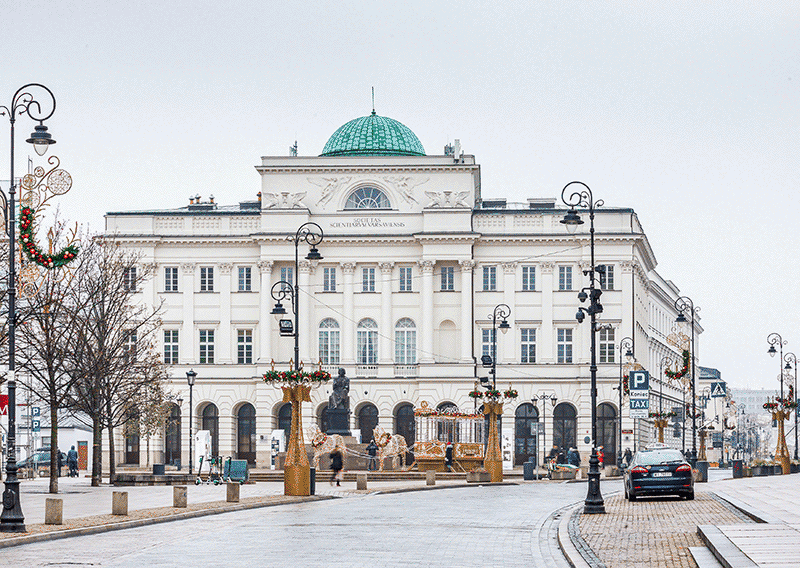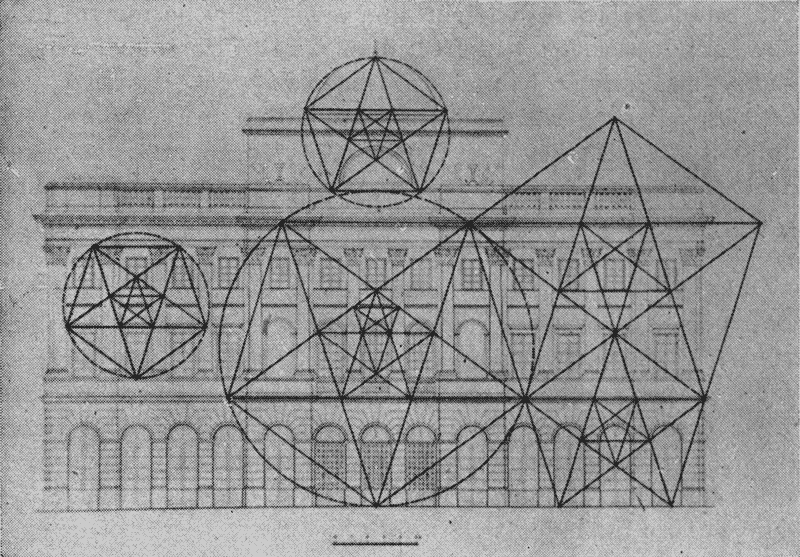In its original shape, the the Staszic Palace housed not only spaces for scientific work but also museum collections, most notably the collection bequeathed to the Warsaw Society of the Friends of Learning by General Jan Henryk Dąbrowski. While the operations of both the Warsaw Scientific Society and the Polish Academy of Sciences reveal continuity with the scientific and culture-forming activities of previous generations, the public and social function of the the Staszic Palace remains obscured, both in relation to the edifice’s space and to the square in front of the palace, its semantics dominated by the Nicolaus Copernicus Monument, interpreted solely as an object commemorating the astronomer. However, it constituted one of the symbolic structures on the square, and its symbolism related to the defined idea of identity and independence aspects seen in terms of nurturing intellectual growth and the sphere of memory.
For this reason, the role of this dedicated Internet is to accent the ongoing activities taking place within the walls of the the Staszic Palace, seen as a continuation of the efforts that represented the crucial functions of this edifice. Moreover, integration is also essential; not only of academics gathered around the institutions affiliated with the palace, but also of the audience belonging to a variety of backgrounds.
This focus on continuity highlights the role of the Polish Academy of Sciences and the institutions housed in the the Staszic Palace, for which, apart from internal operations (the scientific work of individual institutes and the administrative work of the units involved in the structure of the Academy), action for the benefit of society is also important.

The website is a tool supporting this integration as it provides information on current scientific events organized not only in public rooms, but also by individual scientific institutes. The list of scientific institutes and other institutions located in the the Staszic Palace is available in the Institutions section.
In the case of the Staszic Palace, the present layout of the building is not identical to the original Corrazian design (1820-1823). Architectural changes introduced during the reconstruction of the building into St. Tatiana of Rome Catholic Church, designed by Vladimir Pokrovsky (1892-1897), made it impossible to restore the original shape of the building’s interiors. Information about the reconstruction and extension of the building during the works, both under the direction of Marian Lalewicz (1924-1927) and Piotr Biegański (1946-1952), is presented with a division into individual areas of the palace; you can find them in the description of individual halls and interiors. A full account of the architectural works has been made available in the Texts and Images section, where you can consult texts by Piotr Biegański and Marian Lalewicz.
The chronological history of the the Staszic Palace is presented in the Joanna Arvaniti catalogue, which is available in the same section, while the history of the palace’s transformation viewed from the perspective of the affectivity of space and ideological aspects is presented in the work by Aleksandra Wójtowicz. In the articles section you will find a text by Igor Piotrowski on the cultural role of the Staszic Palace as an object on Royal Tact, an article by Hanna Krajewska presenting famous people connected with WTPN and a piece by Katarzyna Słojkowska on archaeological discoveries on the palace grounds. Wartime fate and so far unknown secrets of the Staszic Palace are presented in the text by Krzysztof Kosiński and the article by Waldemar Stopczyński. The Warsaw Scientific Society and a history of the “Józef Mianowski Fund” are presented in the text by Piotr Hübner, Władysław Findeisen, Jan Piskurewicz, Leszka Zasztowt and Jacek Soszyński.
Supporting the organizational activities related to scientific events is the section Spaces of integration – catering, presented in the part devoted to conference rooms.


Reproduction of texts and their fragments, citing and use of the content is possible only with reference to the source, along with the full bibliographic address and the name of the author, e.g.
Review of texts prepared for the website (articles by K. Kosiński, I. Piotrowski, K. Słojkowska, W. Stopczczyński, A. Wójtowicz): dr hab. Zbigniew Tucholski, PhD., professor, Institute of the History of Science, Polish Academy of Sciences
Krzysztof Kosiński, PhD, Professor of the Institute of History of the Polish Academy of Sciences, Institute of History of the Polish Academy of Sciences
Hanna Krajewska, PhD, Director of the Archives of the Polish Academy of Sciences
Igor Piotrowski, PhD, Head of the Urban Studies Laboratory, Institute of Polish Culture, University of Warsaw
Katarzyna Słojkowska, Archives of the Polish Academy of Sciences in Warsaw
Waldemar Stopczyński, President of the Bolesław Srocki Association, Polish language teacher
Joanna Arvaniti, Archives of the Polish Academy of Sciences in Warsaw
Piotr Biegański, Architect, Engineer (died in 1986); author of the plan of postwar reconstruction of the the Staszic Palace
Aleksandra Wójtowicz, PhD, Institute of Literary Research of the Polish Academy of Sciences, assistant professor in the Culture and Literature of Late Modernity Research Group
Professor Władysław Findeisen, Professor Piotr Hübner, Professor Jan Piskurewicz, Jacek Soczyński, professor of Institute of the History of Science, Polish Academy of Sciences
Professor Leszek Zasztowt, Institute of the History of Science, Polish Academy of Sciences
Joanna Arvaniti, Archives of the Polish Academy of Sciences in Warsaw
Aleksandra Wójtowicz, PhD, Institute of Literary Research of the Polish Academy of Sciences
Substantive concept:
Marcin Wochyń, Director of the Auxiliary Activities Department of the Polish Academy of Sciences
Cooperation:
Aleksandra Wójtowicz, PhD, Institute of Literary Research of the Polish Academy of Sciences
Consultation:
The Warsaw Scientific Society
The Digital Humanities Centre at the Institute of Literary Research of the Polish Academy of Sciences
The Polish Academy of Sciences, “Warsaw” Archives
Biuro Upowszechniania i Promocji Nauki PAN
Agnieszka Wojciechowska, The Auxiliary Activities Department of the Polish Academy of Sciences
Translation agency Londoner
The books and articles in the “Publications” section are available on the Staszic Palace website in a digitized version via the Digital Repository of Academic Institutes, thanks to the cooperation of the PAS ZDP and the Library of the Institute of Literary Research of the Polish Academy of Sciences.
Access to the printed version is provided through the cooperation of the PAS ZDP with the Institute of History of Science of the Polish Academy of Sciences and the Warsaw Scientific Society.